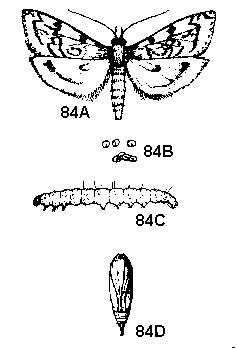 Fig. 84 a-d: Greenhouse
Leaftier, Udea rubigalis (Guenee), Pyralidae, LEPIDOPTERA
Fig. 84 a-d: Greenhouse
Leaftier, Udea rubigalis (Guenee), Pyralidae, LEPIDOPTERAReturn to: MREC Home Page Return to: Key to Caterpillars
DESCRIPTION
Adult - The greenhouse leaftier moth has prominent, black compound eyes. The body and wings are clay brown. The wings are bordered by small black dots and have irregular black lines running across them. The hind wings are boarder than the forewings. The legs are whitish and the antennae are 3/4 the length of the forewings. The wingspan is 18 to 19 mm.
Egg - The egg, white when first laid, later becomes shiny. It is flattened with fine reticulations (ridges) and is 0.8 mm long and0.6 mm broad.
Larva - Tapering towards both ends, the mature larva is slender, pale green with a narrow, darker green band along the back and with a broader, whitish band along each side. The underside of the caterpillar is yellowish and faintly mottled with brownish yellow. The full grown larva is 17 to 19 mm long.
Pupa - The pupa is smoky brown with pale-yellow bands across the abdomen. It is generally smooth and 8.5 to 9.0 mm long and 2.5 mm across.
 Fig. 84 a-d: Greenhouse
Leaftier, Udea rubigalis (Guenee), Pyralidae, LEPIDOPTERA
Fig. 84 a-d: Greenhouse
Leaftier, Udea rubigalis (Guenee), Pyralidae, LEPIDOPTERA
A, Adult. B, Eggs. C, Larva. D, Pupa.
BIOLOGY
Distribution - The greenhouse leaftier is found throughout the United States, Canada, and Central and South America.
Host Plants - The most severely damaged greenhouse plants are chrysanthemum, carnation, cineraria, geranium, marguerite, pot-marigold, rose, snapdragon, and violet. Other hosts of the greenhouse leaftier are azalea, begonia, coleus, ground ivy, and petunia. Celery, beets, and lettuce are outdoor hosts for this insect.
Damage - The larvae usually damage the underside of the leaves by skelonizing them. The plants have a silvery appearance when heavily infested. Later, the damaged areas become pitted. A slight, silken web is spun in a leaf, or between two adjacent leaves and the leaf is folded or woven together to form a shelter area in which the larvae feed.
Life History - Indoors, the greenhouse leaftier can destroy a crop of chrysanthemums or cinerarias in 2 weeks, if not properly controlled. Outdoors, the insect is called the celery leaftier and is a serious pest of celery. It is called "leaftier" because the larvae tie together the leaves of their host plants with silk. This insect is native to America. Greenhouse leaftier moths become active at dusk. Eggs are deposited on the undersurface of leaves singly or in groups of up to 10 with some of the eggs overlapping one another. Each female is capable of laying about 130 eggs. The eggs are deposited in about 13 days. The moth live nearly 35 days; females live a bit longer than males. In approximately 9 days, small larvae hatch from eggs. There are five larval instars requiring 3 to 4 weeks to become full grown. Pupation occurs in folded leaves or in some sheltered area. Adults emerge from the pupae after about 2 weeks. The entire life cycle requires about 6 weeks, so there can be as many as nine generations each year on the greenhouse. Outside there may be four generations during the year.
CONTROL
For special chemical control recommendations, see the current Cooperative Extension Publications on ornamental plant pest management or contact your Cooperative Extension Agent.
Reference to University of Florida/IFAS Pest Control Guides